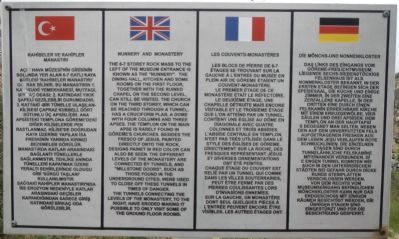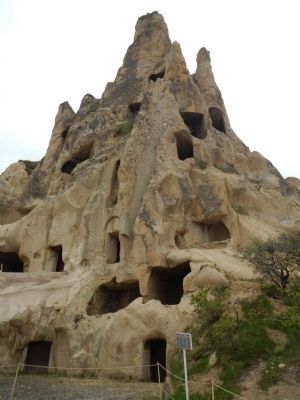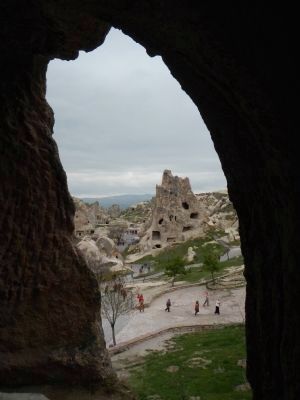Karaseki in Göreme in Nevşehir Merkez, Nevşehir, Turkey — West Asia or Southeast Europe
Nunnery and Monastery
Rahibeler ve Rahipler Manastırı
Les Couvents-Monastères / Die Mönchs-und Nonnenkloster
The 6-7 storey rock mass to the left of the museum entrance is known as the nunnery. The dining hall, kitchen and some rooms on the first floor, together with the ruined chapel on the second level, can still be visited. The church on the third storey, which can be reached through a tunnel, has a cruciform plan, a dome with four columns and three apse is rarely found in Göremes churches. Besides the fresco of Jesus, painted directly onto the rock, designs painet (sic) in red color can also be seen. The different levels of the monastery are connected by tunnels, and millstone doors, such as those found in the underground cities, were used to close off these tunnels in times of danger. The tunnels connecting the levels of the monastery, to the right, have eroded making it possible to only visit some of ground floor rooms.
Turkish:
Açık hava müzesi'nin girisinin solunda yer alan 6-7 katli kaya kütlesi 'rahi̇beler manastırı olarak bilinir. Bu manastırın 1. katıdaki yemekhanesi. mutfağı, birkaç odası; 2. katındaki̇ yıkık şapeli gezilebilir durumdadır. 3. kattaki -blr tünelle ulaşılankiliseli çapraz kubbeli, dört sütunlu üç apsislidir. Ana apsisteki templona Göremedeki diğer kiliselerde pek rastlanmaz. Kilisede doğrudan kaya üzerine yapılan isa freskinin yapılan isa freskinin yanında kırmızı bezemeler görülür. Manastırda katlar arasındaki bağlantı tünellerle sağlanmıstır. Tehlike anında tünelleri kapatmak üzere yeraltı sehirlerinde oldugu gibi sürgü taşları kullanılmıstır. Sağdaki rahipler manastırında ise erozyon nedeniyle katlar arasındaki geçisler kapandığından sadece giriş katındaki birkaç oda görülebilir.
French: Click on the marker image to enlarge it and read the French text.
German: Click on the maker image to enlarge it and read the German text.
Topics. This historical marker is listed in this topic list: Churches & Religion.
Location. 38° 38.367′ N, 34° 50.715′ E. Marker is in Göreme, Nevşehir, in Nevşehir Merkez. It is in Karaseki. Marker can be reached from Müze Cadde, on the right when traveling south. Touch for map. Marker is in this post office area: Göreme, Nevşehir 50180, Turkey. Touch for directions.
Other nearby markers. At least 8 other markers are within walking distance of this marker. Elmalı (Apple) Church (within shouting distance of this marker); Chapel of St. Catherine (within shouting distance of this marker); Chapel of St. Basil (within shouting distance of this marker); Karanlık (Dark) Church (within shouting distance of this marker); Çarıklı (Sandals) Church (within shouting distance of this marker); Chapel of St. Barbara (within shouting distance of this marker); Larder/Kitchen/Refectory (within shouting distance of this marker); Yılanlı (St. Onuphorius) Church (within shouting distance of this marker). Touch for a list and map of all markers in Göreme.
More about this marker. This marker is located at the Göreme Open Air Museum (Göreme Açık Hava Müzesi).
Also see . . . Churches of Göreme. In the 4th century small anchorite communities began to form in the region, acting on instruction of Saint Basil of Caesarea. They carved cells in the soft rock. During the iconoclastic period (725-842) the decoration of the many sanctuaries in the region was held to a minimum, usually symbols such as the depiction of the cross. After this period, new churches were dug into the rocks and they were richly decorated with colourful frescoes. When the Cappadocian Greeks were expelled from Turkey in 1923 in the Population exchange between Greece and Turkey the churches were abandoned. (Submitted on June 3, 2015, by Barry Swackhamer of Brentwood, California.)
Credits. This page was last revised on February 13, 2023. It was originally submitted on June 3, 2015, by Barry Swackhamer of Brentwood, California. This page has been viewed 367 times since then and 12 times this year. Photos: 1. submitted on June 3, 2015, by Barry Swackhamer of Brentwood, California. 2, 3. submitted on June 5, 2015, by Barry Swackhamer of Brentwood, California. • Andrew Ruppenstein was the editor who published this page.


